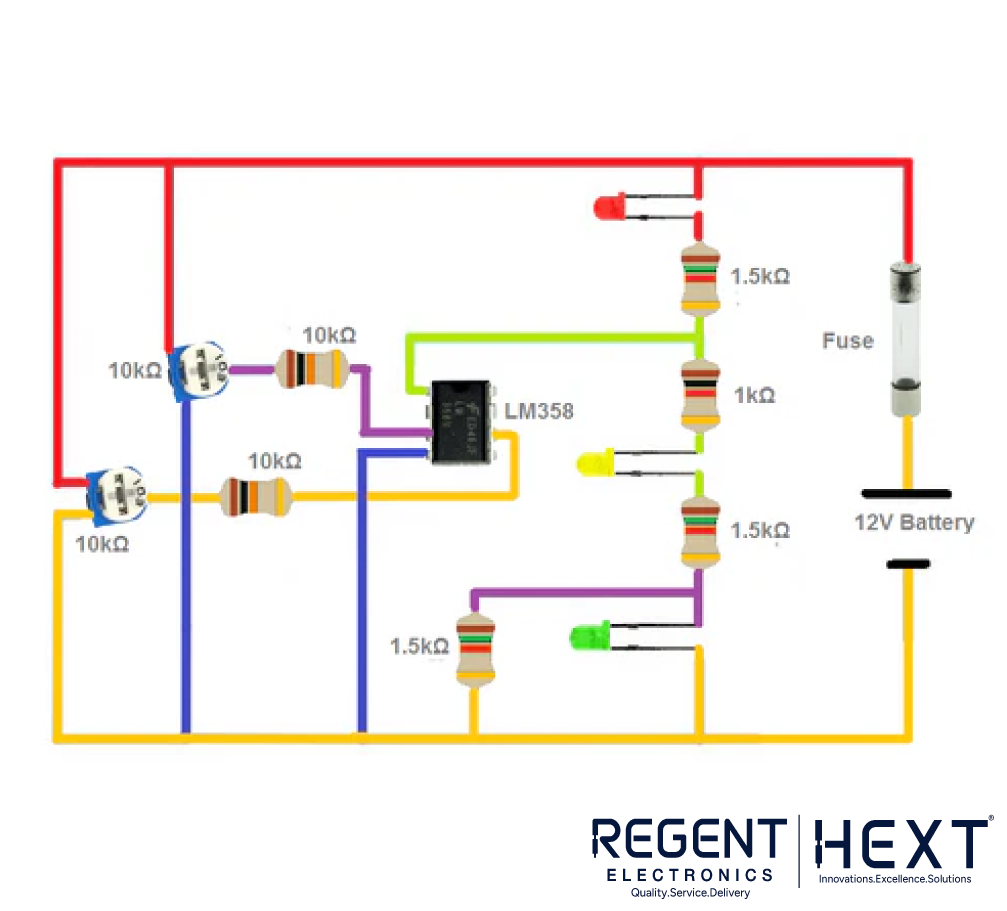
LM358 IC: A Versatile Operational Amplifier and Its Applications
The LM358 Integrated Circuit (IC) is one of the most widely used components in electronics, particularly for sensor applications and a variety of other circuits. Whether you’re working on DIY electronics projects or industrial applications, the LM358 offers numerous benefits and ease of use. In this blog, we’ll explore the LM358 IC, its features, pinout, and several practical applications that can enhance your projects.
What is the LM358 IC?

The LM358 is a low-power, dual-channel operational amplifier (Op-Amp) that operates on a single supply voltage ranging from 3V to 32V DC. It is capable of handling up to 20mA of current per channel. As a single-supply op-amp, the LM358 eliminates the need for a dual power supply, making it an excellent choice for compact and efficient designs. However, it has a limitation: the output cannot go below 0V, as it does not support a negative voltage supply.
This IC is highly regarded for its versatility, low current drain, and wide supply voltage range. Its common applications include signal conditioning, amplification, filtering, and more. Below, we’ll dive deeper into the pinout, features, and real-world applications of the LM358.
Features of LM358 IC
- Dual Operational Amplifiers: Contains two independent, high-gain op-amps.
- Wide Supply Voltage Range: Operates on a single supply voltage between 3V and 32V.
- Low Power Consumption: Suitable for low-power applications.
- Internal Frequency Compensation: Ensures stable operation with minimal external components.
- Wide Common-Mode Voltage Range: Operates from ground to the positive supply voltage.
- Low Input Bias Current: Ensures high precision in signal processing.
- Open-Loop Differential Voltage Gain: High gain for amplifying small signals.
LM358 Pinout

The LM358 IC comes with the following pins:
| Pin Number | Pin Name | Description |
| 1 | OUTPUT1 | Output pin for the first operational amplifier (Op-Amp 1) |
| 2 | INPUT1(-) | Inverting input pin for Op-Amp 1 |
| 3 | INPUT1(+) | Non-inverting input pin for Op-Amp 1 |
| 4 | GND | Ground pin, connected to the negative terminal of the power supply |
| 5 | INPUT2(+) | Non-inverting input pin for Op-Amp 2 |
| 6 | INPUT2(-) | Inverting input pin for Op-Amp 2 |
| 7 | OUTPUT2 | Output pin for the second operational amplifier (Op-Amp 2) |
| 8 | VCC | Positive supply pin, connected to the positive terminal of the power supply |
Applications of LM358 IC
The LM358 is highly versatile and can be used in various applications across different fields. Here are some of the most popular uses:
1. Operational Amplifier Circuits
As an op-amp, the LM358 is used for signal amplification, filtering, and conditioning. Its wide range of applications includes audio processing, sensor signal conditioning, and more.
2. Transducer Amplifiers
The LM358 can amplify signals from sensors and transducers in industrial applications, converting low-level sensor outputs to readable or usable signals.
3. Comparator Circuits
The LM358 can function as a comparator to compare two voltages and output a high or low signal based on which voltage is greater. This is useful for threshold detection in various applications.
4. Battery Monitoring
The LM358 can be used to monitor battery levels and trigger warnings based on voltage thresholds. For instance, you can use it to indicate when the battery charge is low, normal, or full.
5. Active Filters
The IC is also used in active filter circuits, where it helps remove unwanted frequencies from signals.
Using LM358 as a Comparator
In some projects, you may need the LM358 to act as a comparator. Comparators are devices that compare two input signals and output a digital signal (high or low) depending on which input is greater.
Working Principle of LM358 as a Comparator
To use the LM358 as a comparator, you need to provide two input voltages to its op-amps. The IC will then compare these voltages and provide a digital output. Here’s an example of a Digital Dark Sensor using the LM358:
Example: Digital Dark Sensor Using LM358

Working Principle:
A Light Dependent Resistor (LDR) changes its resistance based on the intensity of light. When light strikes the LDR, its resistance decreases, and when there is no light, the resistance increases. In this circuit, the LDR is connected to the non-inverting terminal of the Op-Amp. The output from the op-amp lights up an LED when it detects darkness.
Adjusting Sensitivity:
You can adjust the sensitivity of the circuit by using a potentiometer. If the LED stays on even when there is no darkness, you can adjust the potentiometer to turn off the LED.
Example: 12V Battery Monitoring Circuit Using LM358

This circuit is designed to monitor the voltage levels of a 12V battery and display its status by glowing corresponding LEDs.
Working Principle:
The LM358 monitors the battery’s voltage and indicates whether it is low, normal, or full. Different LEDs light up depending on the battery’s charge. For instance, a red LED turns on at 11V (low battery), a green LED lights up at 12V (full battery), and a yellow LED indicates a normal level between 11V and 12V. This circuit can be easily modified to monitor other voltages like 4V, 6V, or 24V.
Conclusion
The LM358 IC is a versatile, low-power operational amplifier that is widely used in various electronic circuits. Whether you’re building a DIY project or working on industrial applications, the LM358 is an invaluable tool. From basic amplification to complex comparator and battery monitoring circuits, the LM358 can simplify your designs and provide reliable performance.
Explore more possibilities with the LM358 and integrate this powerful IC into your next electronics project. If you’re looking for high-quality LM358 ICs and other electronic components, visit Regent Electronics for all your needs!
By understanding the LM358’s capabilities and applications, you can unlock new possibilities for innovation in your circuits and projects.
